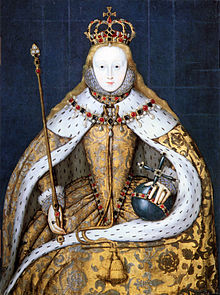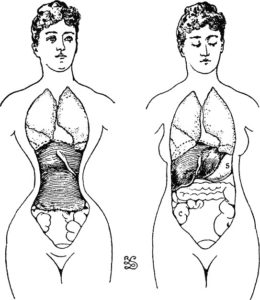‘No pain, no gain’. In Dutch we have a similar saying that is about fashion: ‘If you want to be beautiful, you must suffer’. And fashion dictates what is beautiful and what isn’t. Fashion has probably been with us since humans began to wear clothes. But once in a while, people (women) reject outright the standards of beauty they are expected to meet. This is what happened at the end of the 19th century.
The corset
 Having a small waist in proportion to her body shape has been considered to be an attractive feature of a woman in almost every century. Women used various means to achieve this goal. At first, women wore a restricting bodice made of cloth, tightly laced. From the 16th century onwards heavier means came into use. The bodice was fortified with iron and we saw the birth of the corset. Of course only women of the upper classes could afford to follow such a fashion. If you were bringing in the harvest or were a domestic servant, you needed as much freedom of movement as you could get.
Having a small waist in proportion to her body shape has been considered to be an attractive feature of a woman in almost every century. Women used various means to achieve this goal. At first, women wore a restricting bodice made of cloth, tightly laced. From the 16th century onwards heavier means came into use. The bodice was fortified with iron and we saw the birth of the corset. Of course only women of the upper classes could afford to follow such a fashion. If you were bringing in the harvest or were a domestic servant, you needed as much freedom of movement as you could get.
The corset developed further and further. Thanks to the growth of the whaling industry, baleens (part of the filter-feeder system in the mouths of baleen whales) became available. These materials were more flexible than iron and soon were widely used in corsets .
Damage
 An artificially- tiny waist was not without risks. Women and girls were tightly laced from an early age, preventing the development of their ribs and vital organs. There are examples of corsets that could reduce a waist to 46 cm. I have a tea pot of this size!
An artificially- tiny waist was not without risks. Women and girls were tightly laced from an early age, preventing the development of their ribs and vital organs. There are examples of corsets that could reduce a waist to 46 cm. I have a tea pot of this size!
Opposition
 Opposition against this damaging fashion grew and in 1899 The Hague saw the foundation of the Association of the Improvement of Women’s Clothing, with Marie Jeanette de Lange as its chairwoman. This organisation sought to promote clothes in which women could ‘walk, sit and labour; that enable us to dress and undress without outside help; that enable us to carry our handkerchief, our purse, our keys, that our dress won’t wipe the floor and that we wear hats that fit our heads (…)’. An additional goal: to wear clothes that showed less flesh.
Opposition against this damaging fashion grew and in 1899 The Hague saw the foundation of the Association of the Improvement of Women’s Clothing, with Marie Jeanette de Lange as its chairwoman. This organisation sought to promote clothes in which women could ‘walk, sit and labour; that enable us to dress and undress without outside help; that enable us to carry our handkerchief, our purse, our keys, that our dress won’t wipe the floor and that we wear hats that fit our heads (…)’. An additional goal: to wear clothes that showed less flesh.
Many of the members were also campaigning for women’s right to vote and many of them were professional women. There was also a functional need for a change in women’s fashion, because women had recently become active in pursuits as playing tennis, swimming and cycling.
Reform dress
 The Association promoted wearing the so called ‘reform dress’ — a loose garment, worn without corset and with few decorations. The Association published a monthly magazine with articles about healthier clothes. Every month it included a sewing pattern, enabling women or their seamstresses to make the clothes themselves.
The Association promoted wearing the so called ‘reform dress’ — a loose garment, worn without corset and with few decorations. The Association published a monthly magazine with articles about healthier clothes. Every month it included a sewing pattern, enabling women or their seamstresses to make the clothes themselves.
The reform dress was not widely popular. It was nicknamed ‘hobbezak’, which in translation means ‘baggy dress’. And although it covered the arms and breasts, some people considered the dress too exciting. To give freedom of movement, the skirts were shorter, showing ankles! And in windy weather the loose garment would reveal the contours of a thigh or breast.
What has changed?
 At its peak, the Association had 2000 members. In 1926 the Association decided to dissolve itself. By then women had the right to vote and fashion had become much more woman-friendly.
At its peak, the Association had 2000 members. In 1926 the Association decided to dissolve itself. By then women had the right to vote and fashion had become much more woman-friendly.
But are women completely free from the agony of fashion in this day and age? Search the internet with ‘shapewear’ and look at the breath taking number of results!
Do you want to know more about women in The Hague? Take family or friends on the guided tour ‘The Hague’s Top Women’


